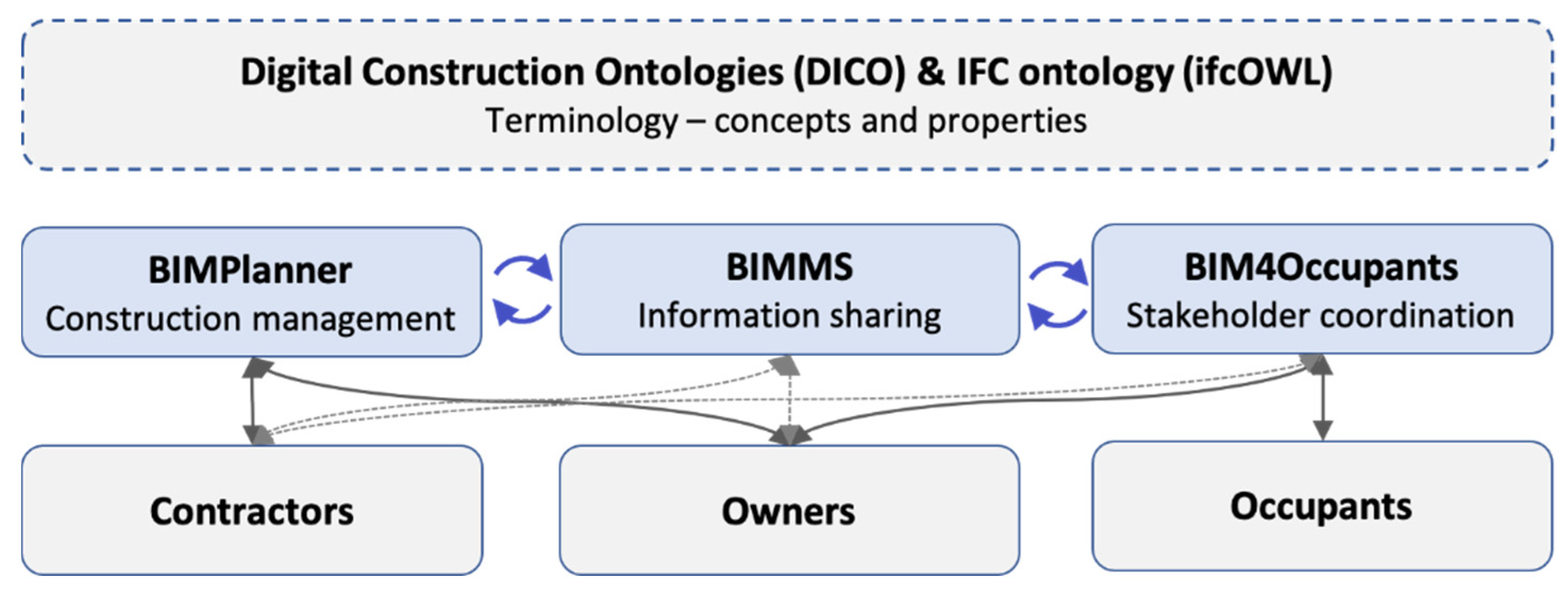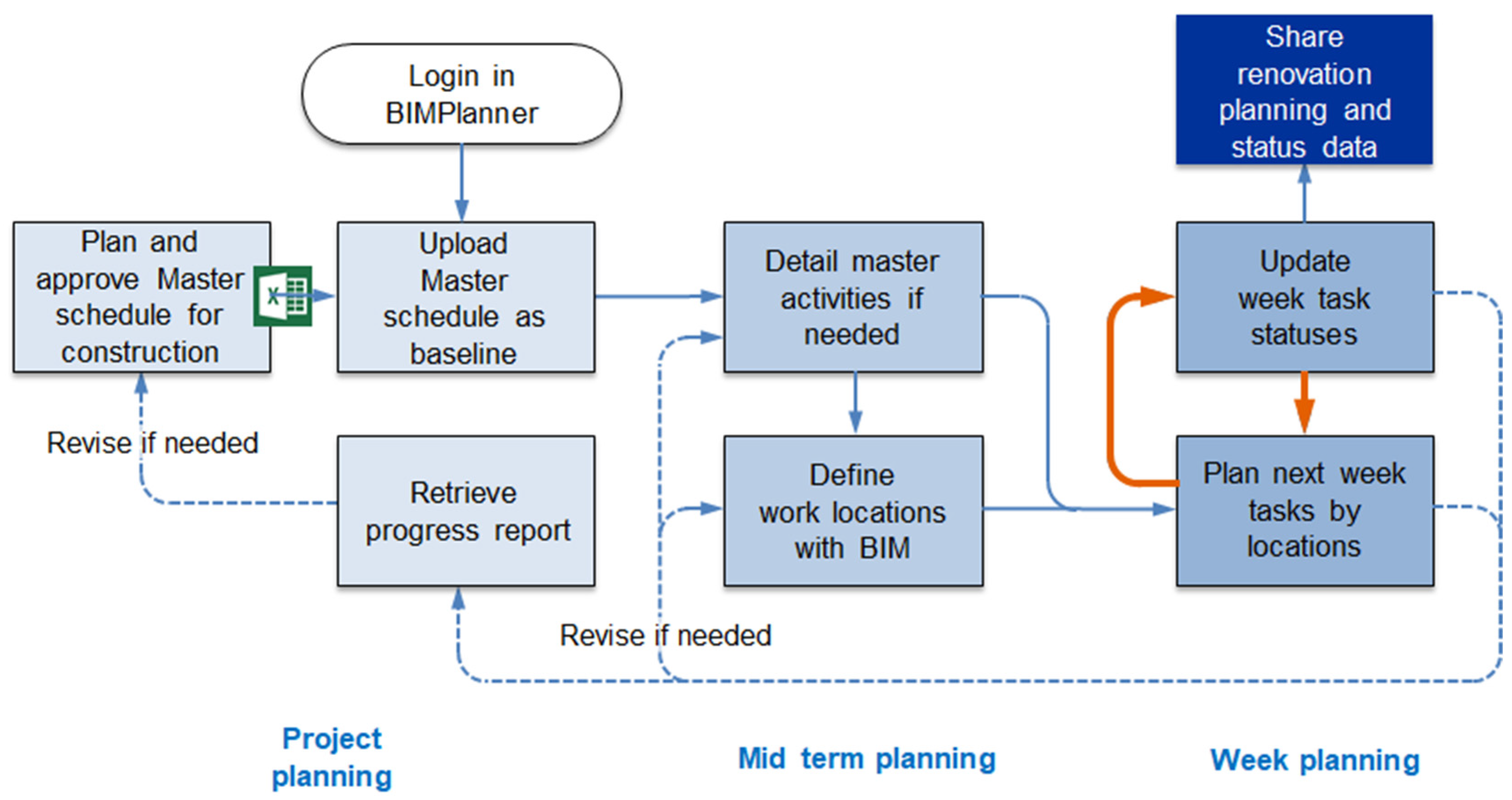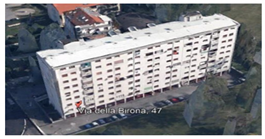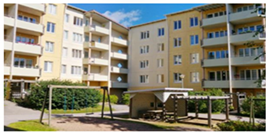1. Introduction
Insufficient communication among the stakeholders of a renovation project is considered as one of the main problems behind low productivity, time delays, and cost overruns. In particular, renovation projects undertaken in occupied buildings are challenging due to the additional risks and logistical requirements caused by the presence of occupants during renovation work, which is known to raise conflicting activities between contractors and occupants. Therefore, an effective communication plan and implementation of proper health and safety procedures are required.
To exacerbate communication challenges, renovation projects contain additional operational uncertainty caused by surprises when existing structures are opened during the construction stage. Static plans specifying when each apartment will be under work are therefore insufficient or, if large time buffers are used, very inefficient. The uncertainty creates a need for real-time coordination solutions that enable flexible and fast reactions to newly discovered problems.
BIM4EEB project is developing BIM-based planning and management tools for renovation operations in occupied buildings. The apartment zones specified in BIM models can be linked both to occupants and to location-based construction plans. Since execution is monitored and plans are revised when needed, there is a continuous digital situation picture of site operations. It can be used to support interaction between contractors and occupants: the plans provide an ongoing prediction when tasks will happen in each apartment and therefore enable targeted notifications to occupants of a particular apartment. Moreover, occupants can provide feedback about plans.
This paper describes two tools under development in BIM4EEB: BIMPlanner—a planning and management tool for renovation projects, and BIM4Occupants—a tool to support interaction between contractors and occupants. An essential technical enabler is an information-sharing layer, which is based on linked data technologies and ontologies, especially the Digital Construction ontology (DICO) for construction management [
1] and ifcOWL ontology for BIM models [
2]. The goal is to enhance information sharing between renovation stakeholders and to enrich BIM data with links to other relevant data in renovation projects. Finally, the paper discusses the demonstrations of the functionalities of these fast-tracking renovation tools at the two pilot sites, Italy and Finland.
2. Methodological Basis for Tool Development
Nowadays, the execution of renovation projects involves numerous systems, devices, and stakeholders that produce large amounts of heterogeneous data. However, since different systems mostly manage their own data, the overall sphere of project information is divergent, incoherent, fragmented, and poorly structured. In such a situation, people need to act as mediators between systems, trying to interpret the information of one system in terms of another. The manual exchange of information is hugely inefficient and error-prone; it also results in processes where information utilisation and exchange are overly infrequent and aggregate. An essential enabler for higher performance renovations is to increase automation of processes, by streamlining and connecting the data in different systems. This goal can be tackled with interoperability solutions.
Currently, technical interoperability problems—exchanging bits and bytes between systems—are solvable by connecting the systems to the net and providing them with application programming interfaces. The syntactic interoperability—shared understanding about the structure of data—can be solved by the use of standard data formats (e.g., XML, JSON, CSV, SPFF) and data types (e.g., XSD). However, at the semantic level—the meaning of data—the interoperability problems are still acute. Ontologies—explicit, shared conceptualisations of domains—are currently developed as a solution for semantic interoperability. There are ontologies with significant usage and benefits in their domains, such as Schema.org for Web site annotation, GoodRelations for electronic commerce, Dublin Core for library metadata, and also a recent ISO/IEC standard of widely used top-level ontology, Basic Formal Ontology (BFO).
In the construction domain, much of ontology development has happened within the Linked Building Data community. The result has been the specification of the ifcOWL ontology as a set of conversion rules from IFC schema [
2]. Due to the existence of converters that can map IFC models into RDF graphs complying to the ifcOWL ontology, it is now possible to utilise BIM models as Linked Data. Further developments are in progress, for example, on Building Topology Ontology (BOT) [
3] and product data representation (ISO 23886/87).
When developing ontologies that connect BIM models to energy efficiency, renovation plans, and occupants, a useful scheme to establish links between different objects is provided by the Lean Construction research [
4,
5], the basis of many advanced construction management methods, such as the Last Planner [
6], Location-Based Management System [
7] and Takt Time planning [
8]. In the activity flow model [
9], each site activity is connected to different kinds of flows: building objects, material batches, locations, labour crews, equipment, information entities, and external conditions. These connections are all defined in Digital Construction (DICO) ontologies [
1]. Each of these connections opens up further links. For example, when a task is linked to an apartment (a work location), and the apartment has further links to its owner and occupant, then the predicted execution time of the task—or any changes to it—can be automatically communicated to them.
3. BIM-Based Tools for Renovation Process Management
3.1. Information Sharing between the BIM-Based Tools
The target users of BIMPlanner are contractors of a renovation project, in particular the main contractor. The BIM4Occupants is meant to support interaction between contractors, and the occupants and owners of a building. The terminology is defined in the Digital Construction ontologies (DICO) and ifcOWL, the IFC ontology. The information sharing between the tools happens through BIMMS, the BIM Management System (
Figure 1).
3.2. BIMPlanner—A Planning and Management Tool for Housing Renovation Projects
BIMPlanner is a cloud-based planning and management tool for housing renovation projects, currently being developed in BIM4EEB project. The tool will enhance fast-track construction, improve safety, and reduce disruption to inhabitants with proactive information. BIMPlanner manages site activities in specifically defined work locations and shares the management information with all stakeholders. The approach is based on the location-based management method defined in Lean Construction literature [
5].
The main contractor prepares a weekly work schedule where site activities are divided into location-specific tasks by work locations. Each work location is reserved exclusively for a task for its planned time of execution. This requires that the work locations used in planning are granular enough so that there is no need for other activities to be executed simultaneously in the same location. This planning method enables the possibility to track start-and-end times of each task by locations, which gives better control to manage work progress and recognise deviations. Better control also allows shorter lead times between activities and consequently leads to shorter overall construction duration. The work locations are defined based on BIM, which provides a possibility to inform occupants and other stakeholders of reserved areas and assure safety aspects.
The BIMPlanner applies a browser-based user interface. In the backend, data are stored in a graph database in RDF format according to DICO and ifcOWL ontologies. The software architecture also contains a GraphQL-interface between the graph database and BIMPlanner application.
Figure 2 illustrates a use scenario for BIMPlanner. The master schedule sets the time targets for the entire construction phase. The master schedule can be prepared in an external system and imported in BIMPlanner. As usual, the master activities are too general for detailed planning. Thus, the user can create new subactivities, which are shown in the week planning. For example, a facade renovation with External Thermal Insulation Composite System can be divided into a few sub-activities that are implemented separately, but as a workflow in different areas of the facade.
The user defines work locations and selects in the 3D-view the object that represents in the best way the intended working area. The indoor work locations can be represented as groups of IFC-spaces, but external work locations need to be defined with grouping structural objects. It shall be noted that those model objects are not the work targets, as in typical 4D-scheduling but representing the work locations indirectly.
Work locations are defined in a hierarchical location breakdown structure (LBS). The user links a subset of work locations (i.e., a branch of LBS, e.g., external locations) with related activities. The detailed planning of site activities is done in week-plan view where planned times for activities are set for each work location. The view spans three weeks: current week, next planning week and one additional week. An important part of the site management is to update the actual start and end times of the week tasks to track work progress continuously and to replan work if needed to achieve master schedule targets.
3.3. BIM4Occupants—A User Application for Renovation Process Collaboration
In an effort to provide a consolidated tool and strategy for optimising renovation process collaboration and minimising as practicably as possible the impact on the building occupants, a BIM-based user application for enhanced renovation process collaboration and information management was developed. The tool focuses on the building occupants by considering them as key actors in the renovation process. The main scope of the application is to engage building end-users, (i.e., building occupants) in a collaborative process with other renovation stakeholders, empowering bidirectional communication and enhanced information exchange. Overall, the Building Occupant Renovation App provides the building occupants with a tool able to capture and communicate their needs and requirements, offering also enhanced visibility on the details of the renovation actions that take place in their building. It is meant as a “guide” for the building occupants during the on-site renovation works, which through an intuitive UI offers the following main features and functionalities:
provision of safety alerts and insights of the ongoing and planned renovation processes, thus enhancing safety and security on-site
enabling occupants’ individual schedules to be expressed and consolidated by the decision-makers into the scheduling of the overall renovation processes, thus assisting in operational planning optimisation while also reducing intrusiveness to their daily lives
enabling occupants to annotate building-elements related information in their premises that might be requested ad hoc by contractors, thus assisting in a faster building-information acquisition and in the constant and collaborative updating of their building’s BIM model, also minimising site inspections/visits to their premises.
Along with the situational-based information for renovation processes and security alerts, notifications are triggered through the app in order to increase user engagement and, therefore, their participation in the renovation management-related activities.
The development of the application follows a typical tier-based architecture with the data management layer to stand as the backbone layer in line with the renovation process ontological model as presented in
Section 3, towards handling information about building elements, renovation processes and information events (i.e., safety alerts and security events). Following the microservices-based concept, different viewpoints on the application are defined by taking into account the features and functionalities as requested during the requirements phase. This modularity of the system is a key element to ensure the customisation and easy adaptation of the building occupant renovation-process application to the diverse end-user needs.
Figure 3 depicts screenshots from the application.
Two different instances of the application are available for the different types of building occupants, the inhabitants and owners. While the look and feel remain the same, a role-based access control mechanism is incorporated at the design of the application in order to ensure that the right information is accessible by each entity, also ensuring the privacy of the application.
3.4. Fast-Tracking Renovation Tool Demonstration Activities
The validation of the fast-tracking renovation framework with the different applications will take place in two buildings of different construction technologies, socio-economic, cultural and behavioural contexts in southern and northern Europe.
Table 1 shows the two residential buildings in Italy and Finland that have been selected as demonstration sites, both representing common building types in their area.
Following the selection of the demo buildings and as part of the co-creation process adopted in the project, the demo site stakeholders, i.e., constructors, building owners, and inhabitants, participated in the design of the tools to fit the specific needs and requirements. Within this context, preliminary engagement activities were performed among the pilot-site stakeholders in order to extract their needs and requirements, further combined with regulatory and legal barriers imposed at the different pilot sites. Therefore, a holistic and user-oriented design and development concept was defined to ensure the delivery of applications and services that best fit users’ needs and expectations.
4. Conclusions
This paper presented two BIM-enabled tools that are being developed in the BIM4EEB project. BIMPlanner is a planning and management tool for housing renovation projects. BIM4Occupants, on the other hand, is a user application for renovation-process collaboration.
The development work has shown that it is indeed possible to provide extensive linking between the BIM models of buildings, different levels of construction plans, locations such as apartments, owners of apartments, construction resources, and information entities. The relations that specify the semantics of the links have been defined in the Digital Construction (DICO) ontology. In particular, the links provide connections from construction tasks to people who need to be informed about them.
The validation of the fast-tracking renovation tools will be further developed in the project, and their functionalities will be demonstrated at two pilot sites, Italy and Finland. Two buildings have been selected to validate the functionalities provided by the different applications, also compared to traditional renovation processes on buildings located in the surrounding areas, which will be used as a baseline. Each application will be evaluated by itself but also under a holistic renovation management framework where the different stakeholders are acting collaboratively in order to ensure the optimal management of renovation tasks. Towards the evaluation of the fast-track renovation framework, a set of key performance indicators have been defined spanning from functional indicators (e.g., reduction of renovation time, the accuracy of the renovation plan, an increase of situational awareness) to user acceptance through the active participation of stakeholders during the renovation and by surveys providing their feedback.
The work on the tools has uncovered the need for the surrounding systems and practices to support the interlinked planning methods. Firstly, the BIM models should contain sufficient information to enable the smooth use of location-based methods; in the minimum, the spaces and zones should be defined. Secondly, good user-interaction methods to support manual linking of entities are still missing. One solution is to provide automatic plan-generation methods that automatically establish the proper networks of links between different entities. A similar problem is the lack of comprehensive methods to visualise linked structures. Thirdly, the software development practices and tools to utilise linked data and ontologies are still in their early stages, and software developers do not generally have the required knowledge and skills as of now. However, there is increasing interest in linked data and ontologies, and we expect these technologies to be important enablers of future renovation management systems.
Author Contributions
Conceptualization, S.T., M.K., R.L., S.K. and K.T.; methodology, S.T.; BIMPlanner software, M.K. and S.T.; BIM4Occupants software, S.K. and K.T.; validation, formal analysis, investigation, resources, data curation, writing—original draft preparation, writing—review and editing, visualization, supervision, S.T., M.K., R.L., S.K. and K.T.; project administration, funding acquisition, M.K., S.T., S.K. and K.T. All authors have read and agreed to the published version of the manuscript.
Funding
This research was funded by BIM4EEB project, grant agreement number 820660, as part of the European Union’s Horizon 2020 research and innovation programme.
Acknowledgments
The authors thank all BIM4EEB partners for their support in all the activities related to the BIMPlanner and BIM4Occupants tools. Nam Vu Hoang, Markus Ylikerälä and Pekka Siltanen also contributed to BIMPlanner.
Conflicts of Interest
The authors declare no conflict of interest. The funders had no role in the design of the study; in the collection, analyses, or interpretation of data; in the writing of the manuscript, or in the decision to publish the results.
References
- Digital Construction Ontologies. 2020. Available online: https://w3id.org/digitalconstruction (accessed on 20 October 2020).
- Pauwels, P.; Terkaj, W. EXPRESS to OWL for construction industry: Towards a recommendable and usable ifcOWL ontology. Autom. Constr. 2016, 63, 100–133. [Google Scholar] [CrossRef]
- Building Topology Ontology. 2020. Available online: https://w3id.org/bot (accessed on 20 October 2020).
- Koskela, L. An Exploration towards a Production Theory and Its Application to Construction. Ph.D. Thesis, VTT Publications 408. Helsinki University of Technology, Espoo, Finland, 2000. [Google Scholar]
- Tzortzopoulos, P.; Kagioglou, M.; Koskela, L. Lean Construction, Core Concepts and New Frontiers; Routledge: Abingdon, UK, 2020; 460p, ISBN 9780367196554. [Google Scholar]
- Ballard, H.G. The Last Planner System of Production Control. Ph.D. Thesis, University of Birmingham, Birmingham, UK, 2000. [Google Scholar]
- Kenley, R.; Seppänen, O. Location-Based Management System for Construction: Planning, Scheduling and Control; Spon Press: London, UK; New York, NY, USA, 2010. [Google Scholar]
- Heinonen, A.; Seppänen, O. Takt Time Planning: Lessons for Construction Industry from a Cruise Ship Cabin Refurbishment Case Study. In Proceedings of the 24th Annual Conference of the International Group for Lean Construction, Boston, MA, USA, 18–24 July 2016; pp. 23–32. [Google Scholar]
- Garcia-Lopez, N. An Activity and Flow-Based Construction Model for Managing On-Site Work. Ph.D. Thesis, Stanford University, Stanford, CA, USA, 2017. [Google Scholar]
| Publisher’s Note: MDPI stays neutral with regard to jurisdictional claims in published maps and institutional affiliations. |
© 2020 by the authors. Licensee MDPI, Basel, Switzerland. This article is an open access article distributed under the terms and conditions of the Creative Commons Attribution (CC BY) license (https://creativecommons.org/licenses/by/4.0/).










